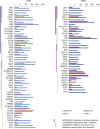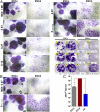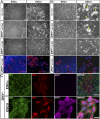Vulnerability of primitive human placental trophoblast to Zika virus
- PMID: 28193876
- PMCID: PMC5338554
- DOI: 10.1073/pnas.1616097114
Vulnerability of primitive human placental trophoblast to Zika virus
Abstract
Infection of pregnant women by Asian lineage strains of Zika virus (ZIKV) has been linked to brain abnormalities in their infants, yet it is uncertain when during pregnancy the human conceptus is most vulnerable to the virus. We have examined two models to study susceptibility of human placental trophoblast to ZIKV: cytotrophoblast and syncytiotrophoblast derived from placental villi at term and colonies of trophoblast differentiated from embryonic stem cells (ESC). The latter appear to be analogous to the primitive placenta formed during implantation. The cells from term placentas, which resist infection, do not express genes encoding most attachment factors implicated in ZIKV entry but do express many genes associated with antiviral defense. By contrast, the ESC-derived trophoblasts possess a wide range of attachment factors for ZIKV entry and lack components of a robust antiviral response system. These cells, particularly areas of syncytiotrophoblast within the colonies, quickly become infected, produce infectious virus and undergo lysis within 48 h after exposure to low titers (multiplicity of infection > 0.07) of an African lineage strain (MR766 Uganda: ZIKVU) considered to be benign with regards to effects on fetal development. Unexpectedly, lytic effects required significantly higher titers of the presumed more virulent FSS13025 Cambodia (ZIKVC). Our data suggest that the developing fetus might be most vulnerable to ZIKV early in the first trimester before a protective zone of mature villous trophoblast has been established. Additionally, MR766 is highly trophic toward primitive trophoblast, which may put the early conceptus of an infected mother at high risk for destruction.
Keywords: Zika virus; embryonic stem cell; placenta; pregnancy; trophoblast.
Conflict of interest statement
The authors declare no conflict of interest.
Figures






Similar articles
-
African and Asian strains of Zika virus differ in their ability to infect and lyse primitive human placental trophoblast.PLoS One. 2018 Jul 9;13(7):e0200086. doi: 10.1371/journal.pone.0200086. eCollection 2018. PLoS One. 2018. PMID: 29985932 Free PMC article.
-
The first trimester human placenta responds to Zika virus infection inducing an interferon (IFN) and antiviral interferon stimulated gene (ISG) response.Virol J. 2025 Apr 19;22(1):108. doi: 10.1186/s12985-025-02729-3. Virol J. 2025. PMID: 40253335 Free PMC article.
-
Zika virus infection of first trimester trophoblast cells affects cell migration, metabolism and immune homeostasis control.J Cell Physiol. 2021 Jul;236(7):4913-4925. doi: 10.1002/jcp.30203. Epub 2020 Dec 10. J Cell Physiol. 2021. PMID: 33305387
-
Immune Evasion Strategies Used by Zika Virus to Infect the Fetal Eye and Brain.Viral Immunol. 2020 Jan/Feb;33(1):22-37. doi: 10.1089/vim.2019.0082. Epub 2019 Nov 5. Viral Immunol. 2020. PMID: 31687902 Free PMC article. Review.
-
Zika virus infection of first-trimester human placentas: utility of an explant model of replication to evaluate correlates of immune protection ex vivo.Curr Opin Virol. 2017 Dec;27:48-56. doi: 10.1016/j.coviro.2017.11.008. Curr Opin Virol. 2017. PMID: 29172071 Free PMC article. Review.
Cited by
-
Research Models and Tools for the Identification of Antivirals and Therapeutics against Zika Virus Infection.Viruses. 2018 Oct 30;10(11):593. doi: 10.3390/v10110593. Viruses. 2018. PMID: 30380760 Free PMC article. Review.
-
Identifying the Critical Gaps in Research on Sex Differences in Metabolism Across the Life Span.Endocrinology. 2018 Jan 1;159(1):9-19. doi: 10.1210/en.2017-03019. Endocrinology. 2018. PMID: 29300998 Free PMC article. Review.
-
Roles of TGF-β1 in Viral Infection during Pregnancy: Research Update and Perspectives.Int J Mol Sci. 2023 Mar 30;24(7):6489. doi: 10.3390/ijms24076489. Int J Mol Sci. 2023. PMID: 37047462 Free PMC article. Review.
-
Deciphering transcriptional regulation in human embryonic stem cells specified towards a trophoblast fate.Sci Rep. 2017 Dec 8;7(1):17257. doi: 10.1038/s41598-017-17614-5. Sci Rep. 2017. PMID: 29222466 Free PMC article.
-
Microbial Vertical Transmission during Human Pregnancy.Cell Host Microbe. 2017 May 10;21(5):561-567. doi: 10.1016/j.chom.2017.04.007. Cell Host Microbe. 2017. PMID: 28494237 Free PMC article. Review.
References
Publication types
MeSH terms
Grants and funding
LinkOut - more resources
Full Text Sources
Other Literature Sources
Medical

